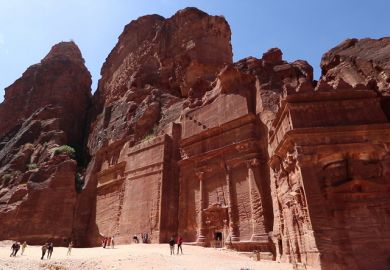Ancient Egyptian hieroglyphs have fascinated Europe for millennia, and the Rosetta Stone remains the British Museum's most visited iconic object. The decipherment that it inspired in the 1820s, however, is still remarkably controversial. The museum's old displays had portraits of the two major scholars, Jean-Francois Champollion and Thomas Young, side by side, and it regularly received protests from visitors complaining that one portrait was larger than the other, although they had identical dimensions. The complaints were usually from French visitors distressed at what seemed to them the lesser size of Champollion's portrait. Such national rivalry was also a major factor in the 1820s, which makes it impossible accurately to assess the various protagonists' roles: English demotists still champion Young, the French uphold Champollion and Italian Egyptologists are sensitive about the student Francesco Salvolini and the theft of some of Champollion's papers after his death. In Britain, no significant biography of Champollion has been available until now. Lesley and Roy Adkins's description of the "race to read the hieroglyphs" is essentially such a biography, and the title echoes one of Young's descriptions of Champollion, in which he claimed that the French scholar had borrowed "an English key".
This book offers a clear and coherent synthesis of Champollion's life, drawing on detailed research in a wide range of sources. The sources are not referenced in footnotes. Given this, the book wisely avoids expounding the conflicting evidence for some of the enduring controversies. For example, when Champollion saw the English copy of the Bankes obelisk, did he decipher the name Cleopatra himself, or did the copy have the annotations by English scholars as they later claimed? Such uncertainties will probably never be resolved; many of the discoveries in the race were not published immediately, and often entered print only in increasingly bitter attempts to claim priority.
The Adkins place the decipherment in its historical context. Rather than offering commentaries on the various uncertainties, or assessing the myth-manufacturing accounts produced by the scholars and their supporters, it organises a huge mass of historical detail into a masterly narrative, making the intricacies of such information easily accessible to the general reader. Champollion's evolving work on the script is described together with integrated accounts of the Egyptian writing systems, allowing the reader to understand what his work was progressively uncovering. The book consistently foregrounds the shaping factors of nationalism, contrasting personalities, and tumultuous politics, with Champollion's ill-health as a recurring theme. No general summary is offered of his character (although the index has entries on "flair for making enemies", "mood swings" and "self-confidence").
The equally remarkable Thomas Young, known among scientists for his work on light and vision, features less, but his contribution and his related work on demotic is judiciously assessed. Both men remain enigmas, but one's sympathies for Young inevitably increase in reading the account of Champollion's progress, and of his realisation that the "foreigner" was not giving him the recognition he believed he deserved for taking the first steps. In turn, Champollion apparently commented after his one hasty visit to London to see the Rosetta Stone that "the English were barbaric". Occasionally, the narrative presents less widely documented characters in a rather one-dimensional manner: W. J. Bankes was a more remarkable scholar and collector than the Adkins suggest, and a study of his scandal-driven travels and exile is now being written by P. Usick. In a strange irony, not noted here, the French copies of inscriptions at Abu Simbel, which later inspired Champollion's legendary moment of revelation, were drawn on an expedition with Bankes.
The book's use of quotations by Champollion conveys the excitement of the work, such as his description of the discovery in Turin of the famous papyrus listing the kings of Egypt and his impressions of travelling through Egypt. The book concludes with a survey of Egyptian writings, indicating the extent of what was unlocked, followed by a useful selection of further reading. This is an admirable work and a welcome addition to Egyptological bibliographies and history.
Richard Parkinson is assistant keeper of Egyptian antiquities, British Museum.
The Keys to Egypt: The Race to Read the Hieroglyphs
Author - Lesley and Roy Adkins
ISBN - 0 00 257091 2
Publisher - HarperCollins
Price - £16.99
Pages - 335
Register to continue
Why register?
- Registration is free and only takes a moment
- Once registered, you can read 3 articles a month
- Sign up for our newsletter
Subscribe
Or subscribe for unlimited access to:
- Unlimited access to news, views, insights & reviews
- Digital editions
- Digital access to THE’s university and college rankings analysis
Already registered or a current subscriber? Login



